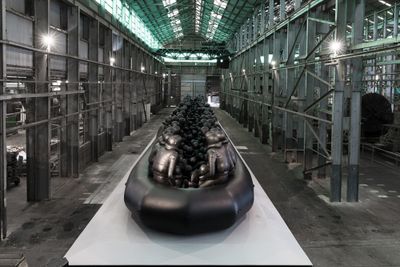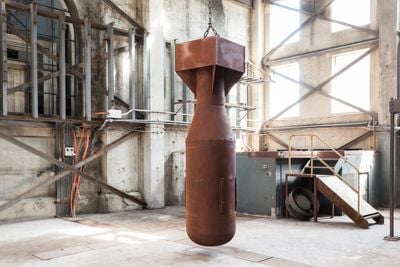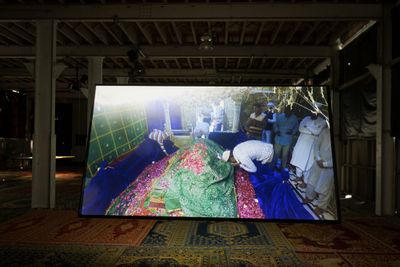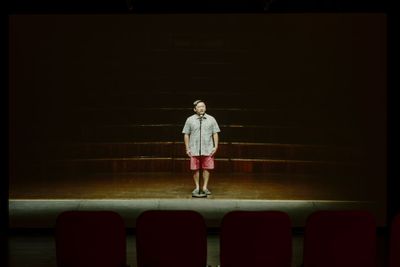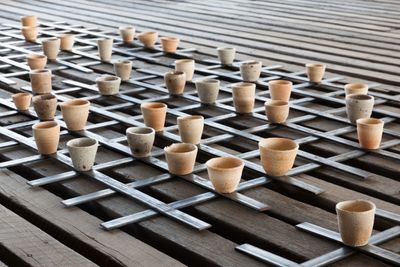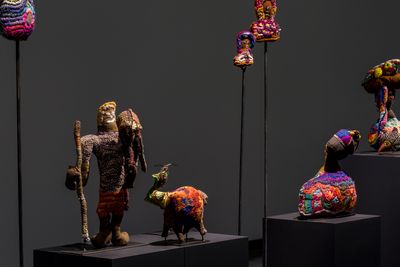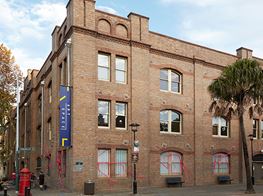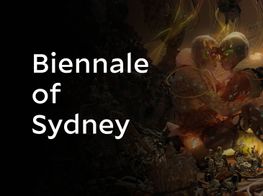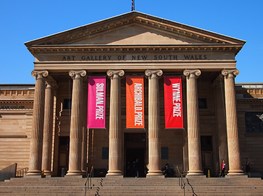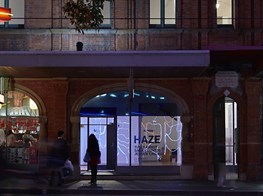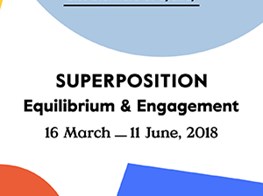Biennale of Sydney: Equilibrium & Engagement
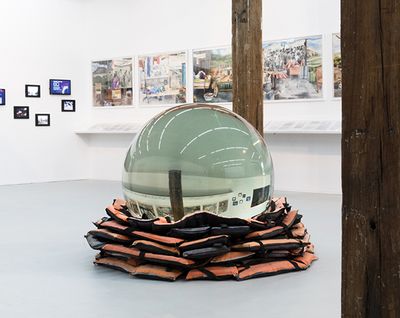
Ai Weiwei, Crystal Ball (2017). Crystal, life jackets. 100 x 100 x 100 cm. Installation view: SUPERPOSITION: Equilibrium & Engagement, 21st Biennale of Sydney, Artspace Sydney (16 March–11 June 2018). Courtesy the artists and the Biennale of Sydney. Photo: silversalt photography.
SUPERPOSITION: Equilibrium & Engagement marks the twenty-first edition of the Biennale of Sydney (16 March–11 June 2018). Curated by Mami Kataoka, it brings together over 70 artists and artist collectives from 35 different countries exhibiting at 7 venues, including the Sydney Opera House, and marks the first time an Asian-born curator has been appointed as the artistic director in the Biennale's 45-year history.
For this Biennale, Kataoka draws inspiration from the quantum mechanical term 'superposition'. In its usual scientific context the term refers to an 'overlapping situation', which Kataoka elaborates on in her curatorial statement: 'microscopic substances such as electrons are said to be dualistic in nature: they paradoxically exist in the form of waves and granular particles simultaneously.' The exhibition explores everyday dualities and multiplicities on macro and micro levels. It does so by drawing on the concept of Wu Xing, whereby everything in this world is made up of the five elements that transmute into each other: wood, fire, earth, metal and water. The curatorial aim is to present 'a panoramic view of how' these elements 'come together in a state of '"equilibrium", while delving into the workings of individual phenomena, considering the equivalence of these opposing notions through the lens of "engagement".'
Essentially, through the prism of superposition we are to read the Biennale not as a thematic show; but as a platform to see a multitude of histories through individual and collective lenses. Instead of the 'East' versus 'West binary, Kataoka interrogates multiple histories that dance together.
There are collective voices at play at the ominous yet spectacular Cockatoo Island, described by the UNESCO World-Heritage List as one of the 'best surviving examples of convict transportation and colonial expansion through convict labour.' This is a primary exhibition site, with its large expansive industrial spaces, labyrinthine tunnels and steep staircases.
The much-hyped Ai Weiwei installation The Law of the Journey (2017) is here: the 60-metre long inflatable lifeboat takes up a huge industrial space, and brims with rows of faceless bodies made from the same black PVC as the raft. Each video in Khaled Sabsabi's five-channel HD video and audio installation, Bring the Silence (2018), features a different visual perspective of the same sacred burial sites, known as maqām in Arabic. Yukinori Yanagi's Absolute Dud (2016), a one-tonne replica of the bomb that was dropped on Hiroshima by the U.S., was probably stored in a similar industrial architecture to its location.
The monumental work The Circle and the Square (2016), by pioneer social practice artist Suzanne Lacy, is staged in a large, dust- and dirt-filled industrial room, in the middle of which a multi-part audio-visual installation depicts a group of people engaged in shape-note singing, an American musical tradition that has origins in Lancashire, as well as Sufi chanting. This project is a result of a two-year undertaking by the artist as part of a 2016 commission by Super Slow Way to explore the cultural and spiritual history of Pendle, Lancashire, with the video staged in Brierfield Mills, a former textiles warehouse that closed in 2007. Lacy worked closely with Pendle residents in a series of community meetings and singing sessions to create a powerful compilation of disparate cultures and religions uniting on common ground.
A sense of common experience is embodied in Brook Andrew's new commission at the Museum of Contemporary Art Australia, What's Left Behind (2018), for which the artist invited four artists—Rushdi Anwar, Shiraz Bayjoo, Mayun Kiki, and Vered Snear—to reflect on 'the idea of memory and that which is present yet also absent'. The installation is comprised of a series of artworks, objects and archives, which the participating artists selected from the Museum of Applied Arts and Sciences, Sydney, that in some way refer to colonialism. These were presented in vitrines and cabinets that resemble a museological display without assuming a completely traditional format.
Archival forms continue at the Art Gallery of New South Wales, where The Biennale of Sydney Archive project has amassed over 40 years' worth of records that relate to the Sydney Biennale's history. Surrounding this centre piece are works composed of active documentation. Cambodian art collective Sa Sa Art Projects presents a table with works produced in collaboration with local and internationalartists, art and media students and former residents of the White Building, a post-independence, social housing complex in Phnom Penh, which was built in1963 and demolished in 2017. In lieu of their historical space, the collective gathered material related to their programming and the communities that they connected with. It is a detailed view of a self-sustained organisation that has emerged outside of institutional support.
Gestures towards community building through material participation continued at 4A Centre for Contemporary Asian Art, where video documentation of theatre director Akira Takayama's performance Our Songs – Sydney Kabuki Project (2018) is on display. The performance was inspired by Japanese Kabuki Theatre and brought residents of Sydney together to share personal material through the form of song. The aftermath of the event is represented in the gallery space as a display of simple A4 sheets with excerpts of poetry, conversations and prose written by audience participants, placed alongside a video documenting some of the performances.
At Artspace Sydney, the archive becomes a tracing of material records. Tanya Goel's Index: pages (builders drawing) (2018) shows an abstract sequence of markings made from blue pigment drawn directly on the gallery wall. Accompanying these drawings is an assortment of found debris obtained from houses in New Delhi, whose modernist architecture was prevalent from the 1950s to the 1970s. Shown nearby are works from Tiffany Chung's 'Vietnam Exodus Project', including the large embroidered textile, reconstructing an exodus history: boat trajectories, ports of first asylum and resettlement countries (2017). Coloured thread highlights aspects of a world map, drawing attention to the migration paths and escape routes of Vietnamese refugees from 1975 to 1996. A series of watercolour paintings, 'water dreamscape—the gangster named Jacky, the sleepers and the exodus' (2017), which depict empty shopfronts and sites of former activity, are placed in conversation with Chung's field notes from researching former Vietnamese refugees now living in Hong Kong, contributing to an expansive body of work that bears witness to the post-war Vietnamese refugee crisis.
That Goel and Chung are positioned in dialogue with Ai Weiwei's Crystal Ball (2017), a large crystal ball nestled in layers of life jackets, says something about Kataoka's approach to this Biennale's 'superpositioning', which avoids a theme-as-methodology approach. What this allows for is a different type of selection process whereby Kataoka has rejected the argument-counterargument format of an essay, and has instead placed loaded works operating at various registers in conversation with one another.
Works of a tactile, handcrafted nature are prevalent throughout the Biennale, from embroidery and crafts to ceramics. At Cockatoo Island, Yasmin Smith's beautifully installed ceramic installation Drowned River Valley (2018) includes a series of small ceramic cup-like vessels, and another separately located series of small ceramic branch- and plank-like works installed at intervals across wooden floor boards. At the Museum of Contemporary Art Australia, Liza Lou presents The Clouds (2015–2018): a large fabric installation made up of 600 individual cloths, each one incorporating minute, handwoven beads. Also at MCA Australia are a series of soft sculptures by members of the Indigenous Australian not-for-profit art centre, Yarrenyty Arltere Artists. Titled In Our Hands (2018), the sculptures are made with recycled woollen blankets, which are dyed using local plants, tea and corroded metal, embellished with wool and feathers.
The fact that Kataoka made a concerted effort to place value on craft-based practices and the labour they represent, whilst balancing the various imbalances of previous Biennale editions, speaks to the underlying triumphs of this exhibition. It offers a broad spectrum of reflection when it comes to thinking through the world today, with Kataoka's 'superpositions' offering an opportunity to acknowledge, address and come to terms with realities that cannot be articulated through a single lens. In a similar way, Kataoka's appointment addressed the serious lack of curatorial engagement from the Asian region in the Biennale of Sydney's institutional history. It would be good to see the Biennale of Sydney build upon this, by appointing an indigenous Australian artistic director for the next iteration—another gap in the programme.—[O]

